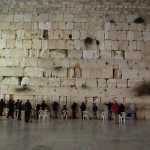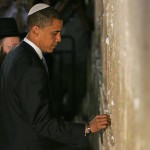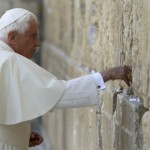Western Wall (Wailing Wall), Jerusalem
Western wall (Wailing Wall in European tradition) — is a part (485 meters long) of the supporting wall around the Temple Mount in Jerusalem that survived after the destruction of the Second Temple (70 A. D.).
The wall was erected at the time of rule of Herod I (37 B. C. — 4 A. D.); it retained an earthwork made to increase the space of the Temple Mount during the renovation and enlarging of the Temple’s building.
The wall was made without any mortar of neatly cut stones (the average height of stones is 1-1.2 meters, length — 1.5-3 meters, some are up to 12 meters long) with a slightly protruding rectangular fine chiseled border on the facial side. To give the wall more resistance against the pressure of the earth filling behind it every next row of brickwork goes a little deeper and farther into it. As the lower rows of the brickwork were being covered by dirt (by the beginning of XIX century only five upper rows of Herodian brickwork remained above the surface of the earth) the wall was built upon; at the present time 19 rows of significantly smaller stones of Roman, Byzantine and later stonework rise above the Herodian stones.
Excavations that began in XIX century allowed the researches to find the remnants of an arch adjoining the western wall — it was one of the supporting arches of the monumental stairway leading to the Temple Mountain, the gates filled with stones (at the level of 22nd row of stonework from the ground), 8.76 meters high, behind which, it seems, there was a stairway leading to the square in front of the Temple, and the remains of a vaulted bridge connecting the square with the Upper City. In 1867-1870 C. Warren with the help of deep mines reached the solid rock ground, on which the wall rests, and determined that around 19 rows of Herodian stonework layers are hidden beneath the ground.
Until 1968, systematic research of the Western Wall was impossible: first, because of the prohibition of the Turkish authorities; and in the time of the British mandate and the dominion of Jordan –– because of resistance of Arabic clergy. In February of 1968, B. Mazar began carrying out of excavations of the Western Wall and the adjoining section scheduled for many years. The data received from the excavations not only enriched science with new information but also allowed to correct a number of mistakes related to the character and purpose of the buildings, the remains of which were found earlier.
In the Jewish religious-national mentality the Western Wall is a sanctuary, since it is a remaining part of the Temple complex. In the first ages after the destruction of the Temple the Jews gathered to pray on the Holy Mountain, from which there is a view on the Temple square. However, starting from V century a tradition began to form to pray by the Wailing Wall, which gradually became a symbol of the Jewish nation’s relation to its historical motherland; it turned into a place where the Jews weep over the destruction of the Temple and pray to God for the recovery of Israel in his country. The sanctity of the Western Wall as well as the obstacles to access it created at different times by Moslem authorities caused the Jews to try to redeem from the Moslems the Wailing Wall or at least the areas neighboring it. These proposals each time encountered a firm rejection from Moslem leaders; the reason for the rejection was a tomb of a Moslem saint located near the Western Wall.
After the declaration of Balfour was published on November 2, 1917, which granted the Jews the right to restore their national hearth in Palestine, the Western Wall turned into a focus of growing instability. The Arabs, who long before that were doing all they could to hinder the Jews from praying near the Wailing Wall and sometimes even attacked the praying ones, came up with a statement that the Western Wall, being an integral part of the Al-Aqsa mosque located on the Temple Mount, is a Moslem sanctuary. In 1920s, the Arabic clergy spread around a legend (that did not have any ground in Moslem religious tradition) that prophet Muhammad, after having come on his legendary steed Al-Buraq to Jerusalem, tied it by the Western Wall and by doing so sanctified it. One of the most ardent supporters of the Moslems inviolability of rights on the Western Wall was hajj Amin Al-Husayni, who by the end of 1920s became a mufti of Jerusalem and headed up an anti-Jewish campaign in Erets-Israel. Cases of attacking Jews increased, especially those who prayed near the Western Wall and approached it coming through Arabic quarters; on Yom-Kippur in 1928 the Arabs destroyed the partition wall dividing males and females praying by the Western Wall.
Pages: 1 2




